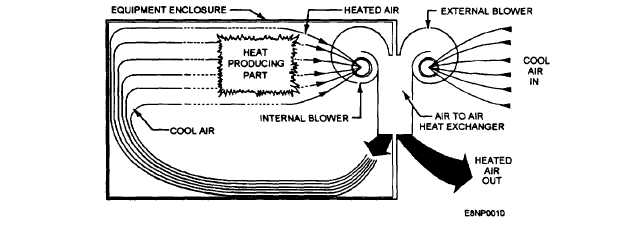Figure 1-3.—Forced-air coding.
FORCED-AIR COOLING
The increase the cooling effect over that provided by
convection cooling, forced-air cooling (fig. 1-3) uses a
blower to provide air movement instead of the natural
convection currents. Cool air is drawn into the
equipment enclosure and flows past the heat producing
part, picking up the heat. The air is then exhausted out
of the equipment. An air filter is provided at the air inlet
to remove dust and dirt that otherwise would settle on
the internal parts of the equipment. The air filter must
be kept clean according to the equipment’s maintenance
requirements. This will ensure maximum air movement
and cooling.
In some equipment, a honeycomb rf interference
filter is installed on both input and outlet to prevent stray
rf from entering or leaving the equipment cabinet. This
filter can also collect dirt that can reduce the airflow.
Failure of a bearing in the blower motor is not an
uncommon problem. A replacement of both blower
motor bearings or blower assembly is warranted at the
first sign of abnormal operation, such as excessive noise
or vibration. It is better to replace the bearings than to
risk damage to the equipment that the blower motor is
designed to protect.
AIR-TO-AIR COOLING
Some units of electronic equipment are
hermetically sealed to prevent the entrance of moisture.
For equipment of this type, an air-to-air heat exchanger
(fig. 14) is used to prevent the air inside the equipment
enclosure from mixing with the outside air and still
allow cooling to take place. Air moving past the heat
producing part absorbs heat and is forced through a heat
exchanger by an internal blower. The heat in the internal
air is absorbed by the heat exchanger. The cooled
internal air is then returned to the equipment interior to
continue the cycle.
Figure 1-4.—Air-to-air cooling.
1-2





